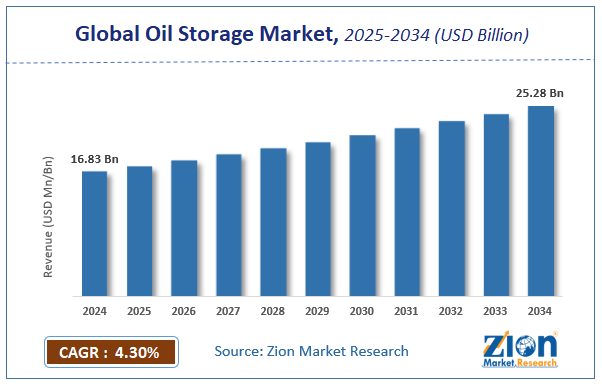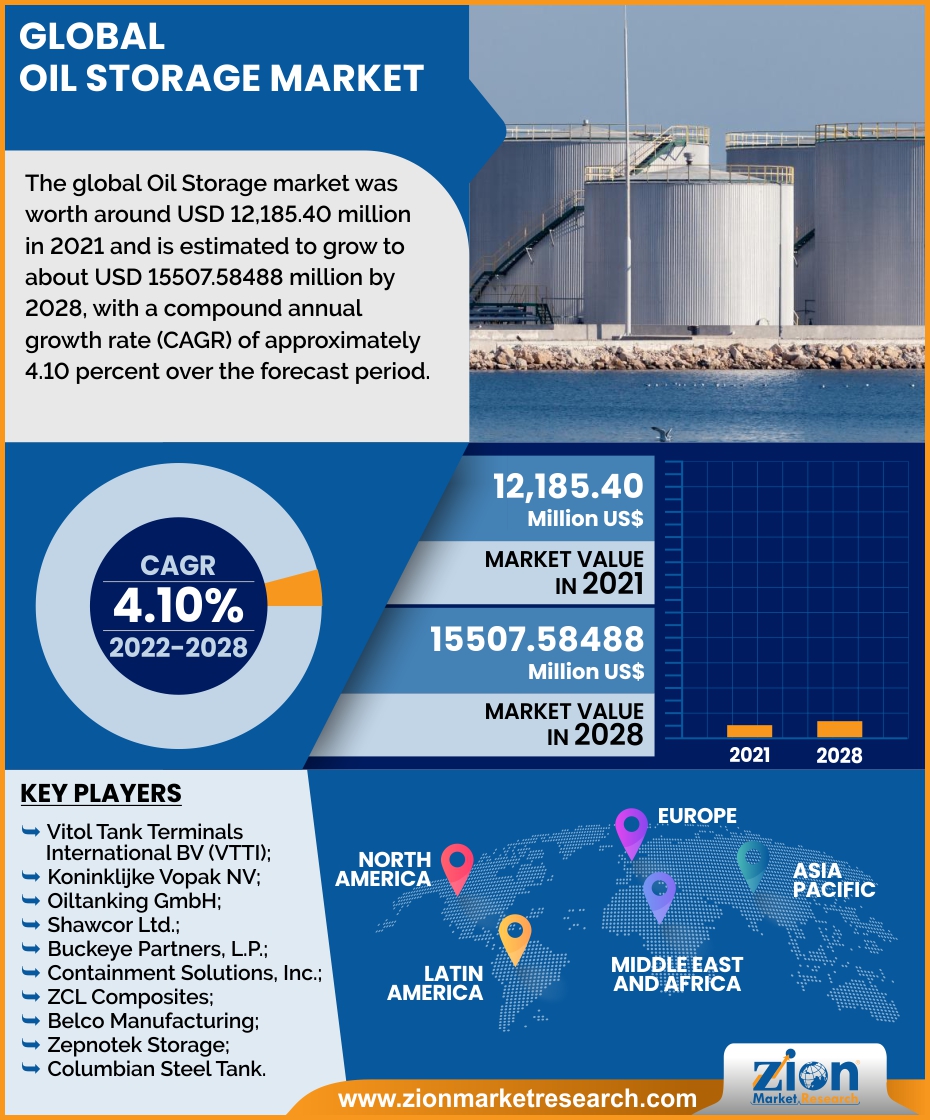Oil Storage Market Size, Share, Analysis, Trends, Growth, 2028

Oil Storage Market By Application Outlook (Crude Oil, Middle Distillates, Gasoline, Aviation Fuel and Others) By Product Outlook (Open Top, Fixed Roof, Floating Roof and Others) and By Region - Global Industry Overview, Market Intelligence, Comprehensive Analysis, Historical Data and Forecasts 2022 - 2028
| Market Size in 2021 | Market Forecast in 2028 | CAGR (in %) | Base Year |
|---|---|---|---|
| USD 12,185.40 Million | USD 15507.584 Million | 4.5% | 2021 |
Industry Prospective:
The global Oil Storage market was worth around USD 12,185.40 million in 2021 and is estimated to grow to about USD 15507.58488 million by 2028, with a compound annual growth rate (CAGR) of approximately 4.10 percent over the forecast period. The report analyzes the Oil Storage market’s drivers, restraints/challenges, and the effect they have on the demands during the projection period. In addition, the report explores emerging opportunities in the Oil Storage market.
Oil Storage Market: Overview
Petroleum products require the use of oil storage tanks during the production, refining, and distribution processes. The tank selection process can be influenced by product operating conditions, storage capacity, and specific design issues. The types of products used to feed the world's refineries have undergone significant changes in the petroleum industry. Because of the increased use of petroleum products, the industry has been forced to look for alternative supply sources. Product, physical, and chemical property changes present new challenges to the storage tank industry. Environmental and safety concerns are still a major consideration in the selection and design of petroleum storage tanks industry.
Open-top tanks (OTT), fixed-roof tanks (FRT), external floating-roof tanks (EFRT), and internal floating-roof tanks (IFRT) are the most common types of atmospheric storage tanks (AST) in use (IFRT). A closed floating-roof tank (CFRT) may be chosen depending on the product. Over the forecast period, the market is expected to be driven by an increase in oil and gas production activities and a surge in demand for crude oil in several end-use sectors. Due to rising crude oil demand and the need to store large amounts of crude oil, suppliers are concentrating on inventories and infrastructure development. Furthermore, fluctuating crude oil prices have resulted in oil-importing countries bolstering their energy security by increasing oil storage.
COVID-19 Impact:
COVID-19 has had a significant influence on the world economy, wreaking havoc on global trade and affecting households, businesses, financial institutions, industrial facilities, and infrastructure corporations all at the same time. The new coronavirus has had an impact on numerous economies and has triggered lockdown in many nations, limiting market growth. The closure of an industrial manufacturing resulted in a drop in demand for fossil fuels in the transportation and aviation sectors, which slowed the growth of the oil storage industry. The production operations at both offshore and onshore locations have been halted due to a drop in demand for oil and oil products. As a result of the industrial shutdown, development and upgrade projects for oil storage tank terminals are projected to be put back even more.
Oil Storage Market: Growth Drivers
Driver: Demand for Various Crude Oil derived products is supporting the growth of Terminals
A petroleum refinery's outputs include petroleum products obtained from crude oil, such as diesel, petroleum, aviation fuel, lubricants, and others. Every barrel of crude oil processed at a typical refinery yields a diverse range of products. Propane and butane are the most often produced refined products that are used as feedstock for ethylene cracking and then mixed into Liquefied Petroleum Gas (LPG) for use as a fuel. In industrial facilities and commercial/residential heating, industrial gasoline is utilized as a furnace fuel. Remaining oil is also used as a bunker fuel in power plants and huge ocean-going ships. These reasons have increased demand for diesel, petroleum, oils, and other products, all of which directly drive the demand for more crude oil.
Restraint: Emphasis on Adoption of Renewable Energy Resources to Alter Oil Industry Growth
The increased adoption of renewable energy sources for electricity generation is a major restraint on the oil storage terminals market. Because renewable fuels are often less polluting, environmental concerns have surpassed energy security as the primary motivation of government efforts to encourage them. Oil and natural gas-based fuels, biofuels generated from vegetable matter such as ethanol or biodiesel, electric vehicles (EVs), and hydrogen-based fuel cells have all been the focus of alternative automotive-fuel research and development in recent years. Another factor limiting the growth of the oil storage terminal industry is the high cost of construction and maintenance necessary during the terminal's operational lifetime.
Opportunity: Difference between crude oil demand and supply
Crude oil is used as a raw material in the production of refined products, hence demand for crude oil is closely related to demand for petroleum products. The demand for crude oil has been impacted by a decrease in the use of refined products. As a result, the volume of oil stored increased, necessitating the construction of crude oil storage facilities. As a result, during the projected period, a mismatch between crude oil demand and supply is expected to provide profitable prospects for the global oil storage market.
Challenge: Investments are decreasing, mostly in the energy and power sectors
The market saw a major drop in investment, particularly in the energy and electricity sectors. Investments in the energy and electricity sectors are expected to fall by 10% in 2021, according to the International Energy Agency's estimates. This reflects the current state of the global marketplace as well as the significant challenges that it faces.
Global Oil Storage Market: Segmentation
The global Oil Storage market is segregated based on Application Outlook and Product Outlook.
By Application Outlook, the market is classified into Crude Oil, Middle Distillates, Gasoline, Aviation Fuel and Others. This category had a significant share in 2021 and is expected to maintain its dominance throughout the forecast period. The global oil storage market is dominated by the crude oil segment. Crude oil is the raw material for many of the goods that are created and utilized around the world, including diesel, gasoline, aviation fuel, kerosene, and others. In recent years, the vehicle sector has experienced exponential growth, and new goods such as liquefied natural gas have applications in this field. The demand for storage terminals has risen as LPG has become more widely adopted in emerging countries.
By Product Outlook, the market is divided into Open Top, Fixed Roof, Floating Roof and Others. The global oil storage market is dominated by floating roof tanks. In pumping stations and terminals where crude oil is stabilized at vapour pressures less than 11.1 psia, floating roof tanks are commonly employed. The cylindrical floating roof tank is suspended above the ground. External floating roof tanks and internal floating roof tanks are the two types of floating roof tanks. A cylindrical steel shell with an open top serves as the exterior floating roof tank. The roof is afloat on the liquid's surface. Depending on the liquid level, the ceiling rises and falls.
Oil Storage Market: Report Scope
| Report Attributes | Report Details |
|---|---|
| Report Name | Oil Storage Market |
| Market Size in 2021 | USD USD 12,185.40 Million |
| Market Forecast in 2028 | USD USD 15507.58488 Million |
| Growth Rate | CAGR of 4.1% |
| Number of Pages | 188 |
| Key Companies Covered | Vitol Tank Terminals International BV (VTTI); Koninklijke Vopak NV; Oiltanking GmbH; Shawcor Ltd.; Buckeye Partners, L.P.; Containment Solutions, Inc.; ZCL Composites; Belco Manufacturing; Zepnotek Storage; and Columbian Steel Tank. |
| Segments Covered | By Application, By Product and By Region |
| Regions Covered | North America, Europe, Asia Pacific (APAC), Latin America, Middle East, and Africa (MEA) |
| Base Year | 2021 |
| Historical Year | 2016 to 2020 |
| Forecast Year | 2022 - 2028 |
| Customization Scope | Avail customized purchase options to meet your exact research needs. Request For Customization |
Recent Developments
- In July 2021, Oil tanking is pleased to announce that it has acquired Antwerp Gas Terminal N.V., one of Europe's major independent LPG and petrochemical gas terminals, strengthening its position as a leading global independent gas storage partner.
- In December 2020, Oiltanking successfully concluded an online electronic auction for Jet Fuel/USLD storage capacity at the Oiltanking Copenhagen site in collaboration with Matrix Global ("Matrix"). The auction resulted in the sale of 77,150 cbm of storage capacity each month for Calendar 2021.
Regional Landscape
Due to the sheer strong demand for oil storage across the region, North America held a substantial market share in 2021. The need for oil storage is directly influenced by rising exploration and production operations linked with shale gas reserves. The presence of a substantial US strategic petroleum reserve is expected to boost regional growth even further.
Over the forecast period, Asia Pacific is expected to have the second-fastest growth rate, with China accounting for the greatest share of the regional market. The APAC market is expected to be driven by rising oil and gas demand from key markets such as China and India, as well as increased investments in offshore and onshore operations.
Competitive Landscape
Some of the main competitors dominating the global Oil Storage market include –
- Vitol Tank Terminals International BV (VTTI);
- Koninklijke Vopak NV
- Oiltanking GmbH
- Shawcor Ltd.
- Buckeye Partners
- L.P.
- Containment Solutions, Inc.
- ZCL Composites
- Belco Manufacturing
- Zepnotek Storage
- Columbian Steel Tank.
The market is segmented as follows:
By Application Outlook
- Crude Oil
- Middle Distillates
- Gasoline
- Aviation Fuel
- Others
By Product Outlook
- Open Top
- Fixed Roof
- Floating Roof
- Others
By Region
- North America
- The U.S.
- Canada
- Europe
- France
- The UK
- Spain
- Germany
- Italy
- Rest of Europe
- Asia Pacific
- China
- Japan
- India
- South Korea
- Southeast Asia
- Rest of Asia Pacific
- Latin America
- Brazil
- Mexico
- Rest of Latin America
- Middle East & Africa
- GCC
- South Africa
- Rest of Middle East & Africa
Table Of Content
Methodology
FrequentlyAsked Questions
The market is expected to be driven by an increase in oil and gas production activities and a surge in demand for crude oil in several end-use sectors. Due to rising crude oil demand and the need to store large amounts of crude oil, suppliers are concentrating on inventories and infrastructure development.
According to the Market Research report, the global market was worth around USD 12,185.40 million in 2021 and is estimated to grow to about USD 15507.58488 million by 2028, with a compound annual growth rate (CAGR) of approximately 4.10 percent over the forecast period.
Due to the sheer strong demand for oil storage across the region, North America held a substantial market share in 2021. The need for oil storage is directly influenced by rising exploration and production operations linked with shale gas reserves.
Some of the main competitors dominating the global Oil Storage market include - Vitol Tank Terminals International BV (VTTI); Koninklijke Vopak NV; Oiltanking GmbH; Shawcor Ltd.; Buckeye Partners, L.P.; Containment Solutions, Inc.; ZCL Composites; Belco Manufacturing; Zepnotek Storage; and Columbian Steel Tank.
RelatedNews
HappyClients
Zion Market Research
Tel: +1 (302) 444-0166
USA/Canada Toll Free No.+1 (855) 465-4651
3rd Floor,
Mrunal Paradise, Opp Maharaja Hotel,
Pimple Gurav, Pune 411061,
Maharashtra, India
Phone No +91 7768 006 007, +91 7768 006 008
US OFFICE NO +1 (302) 444-0166
US/CAN TOLL FREE +1 (855) 465-4651
Email: sales@zionmarketresearch.com
We have secured system to process your transaction.
Our support available to help you 24 hours a day, five days a week.
Monday - Friday: 9AM - 6PM
Saturday - Sunday: Closed







